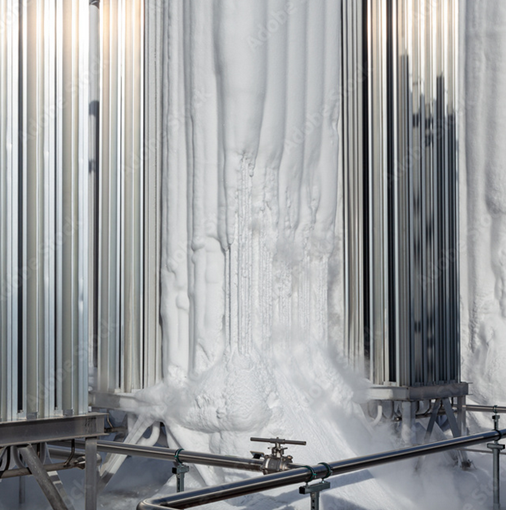
amixon® offers the possibility of piloting with your original products. The process reactors are temperature-controlled (350°C), vacuum-tight (10 mbar) and pressure-tight (25 bar).
Inerting of mixers and mixing goods
Oxygen is an aggressive oxidant and sometimes undesirable
Oxygen is present in our ambient air at a level of 21%. Many unwanted reactions only take place when oxygen is present. The oxygen can be effectively banished from the mixing chamber by evacuating the ambient air from the mixing chamber. This is done when the mixing chamber is purged several times with an inert gas. Instead of purging, the mixing chamber can also be vacuumed (several times in succession, if necessary) and filled with an inert gas.
The inert gas to be selected should be inexpensive. Nevertheless, oxidation and unwanted reactions should be suppressed. Normally, all noble gases such as xenon, neon, helium, argon or krypton can be used as inert gases. The less expensive nitrogen is also an inert gas if the process temperature remains below 180°C. Carbon dioxide also functions as an inert gas. Would you like to learn more about Atex and mixing tests?
Inertization of bulk materials
Bulk goods susceptible to oxidation, especially spices, instant food of high-quality or baby food will keep much longer if oxidizing atmospheric oxygen is eliminated. Oxygen in the air is eliminated. The mixed goods can be vacuumed in the mixer and then and then pressurized with an inert gas to ambient pressure before packaging/ filling takes place. In practice, a mixture of nitrogen and CO2 gas is often used. The inert gas composition is significant when the finished goods are transported to other climatic zones. The inert gas in gas-tight packaging should have expansion coefficients as similar as possible to the as the ambient air. Would you like to learn more about tests in the amixon® technical center?
The material in contact with the product is Alloy 59, a nickel-based material with the designation 2.4605. It has similar strength to boiler plate. The corrosion resistance is comparable to that of nickel.

Cryogenic cooling is effective, but expensive.
Cryogenic cooling of bulk materials
Nitrogen can be used in gaseous form in compressed gas cylinders or cryogenically as liquid nitrogen. Carbon dioxide can be stored in compressed gas cylinders or in the form of dry ice pellets. Carbon dioxide dry ice sublimates at -78°C. Liquid nitrogen is stored at -196°C in isolation and pressure tanks. It evaporates at atmospheric conditions and therefore has a limited shelf life.
With cryogenic media, bulk materials can be cooled extremely quickly. Rapidly changing aggregate states trigger large enthalpy jumps. This type of cooling is called cryogenic cooling. If carbon dioxide dry ice or liquid nitrogen is used in the mixing chamber, large volumes of gas are spontaneously generated. The spontaneous increase in volume can be a problem. The gas volumes must be safely removed. The gas may be contaminated with dust and require filtration before it can be discharged to the outside. If so, there is a risk of the filter media falling below the dew point. The cryogenically generated dust is colder than the ambient temperature.
Caution. Handling inert gases involves risks
Care must be taken when handling inert gases. They are odorless and colorless. In this respect, the signs of a suffocation hazard cannot be detected by the user. In any case, the experimental room should be well ventilated and the oxygen content measured continuously at several points. The oxygen measurement must be carried out in particular whenever the inspection door or the nozzle of a previously inerted system is opened. The danger must not be underestimated. It is necessary to train the employees regularly and in detail!
© Copyright by amixon GmbH

